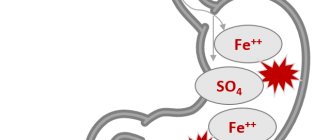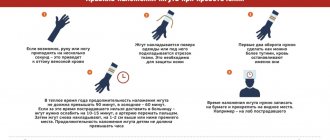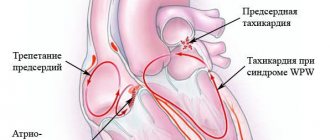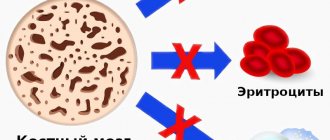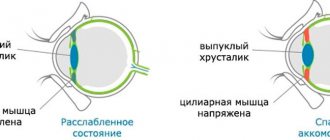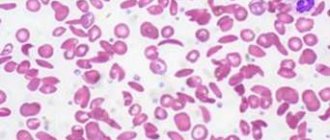Anemia
or
“anemia”
- a decrease in the concentration of hemoglobin in the blood below established standards, most often, with a simultaneous decrease in the total volume of red blood cells (red blood cells that carry oxygen). Anemia, as a secondary symptom, can accompany various diseases, causing the development of oxygen starvation of tissues. The patient experiences chronic fatigue and weakness, constant drowsiness and loss of strength, dizziness and shortness of breath.
Anemia in men and women
Anemia is one of the most common diseases among the adult population of the Earth today. Risk groups for developing anemia include:
- lovers of vegetarian cuisine.
- patients suffering from large blood losses due to the physiological characteristics of the body or a number of chronic diseases.
- pregnant women.
- professional athletes.
Anemia in men is diagnosed in the presence of malignant neoplasms or hidden bleeding of the gastrointestinal tract, peptic ulcer, hemorrhoids and other pathologies. A decrease in the level of hemoglobin in a woman’s blood can be associated with heavy menstruation, pregnancy and lactation, and a period of hormonal changes during menopause. Varying degrees of anemia also appear in children due to lack of adequate nutrition, impaired absorption of iron in the gastrointestinal tract, gastritis or parasitic diseases, limited exposure to fresh air and physical inactivity.
Anemia - what is it and how dangerous is it?
This disease is also called anemia. This is a clinical-hematological syndrome that can occur as a consequence of one or another pathology. Hemoglobin protein is synthesized in the bone marrow with the participation of iron and is a component of erythrocytes - red blood cells. It delivers oxygen to the tissues and also helps to utilize carbon dioxide, delivering it to the lungs.
Such an important function easily explains the dangerous consequences of anemia. Firstly, even in conditions of a lack of iron in the diet, the body will fight anemia with all its might: first there will not be enough iron in the tissues and organs, and only lastly in the blood. This means that anemia often accompanies serious bone marrow diseases, tumors, and severe hematological diseases. It is important to pay attention to anemia as early as possible for this reason.
Secondly, a decrease in hemoglobin levels can lead to the following consequences:
- weakening of protective forces and increased susceptibility to aggressive environmental factors;
- decreased physical endurance and tolerance to intellectual stress;
- high risks of developing heart disease;
- high risks of developing purulent-septic processes.
Pregnant women deserve special attention. Anemia during pregnancy can lead to a high probability of spontaneous abortion, fetal malnutrition and intrauterine growth retardation, the appearance of hypoxia, and discoordination of labor. Physiological blood loss during childbirth or during a cesarean section will not cause complications in a healthy woman, but in an expectant mother with anemia it can also cause serious consequences.
Principles of classification of anemia
There are several types of classifications of anemia, based on a number of signs - the cause of the disease, the mechanism of its development, stages, symptoms and other parameters. The following groups are distinguished:
Sign up for an anemia screening
Make an appointment
Why does anemia occur?
Anemia can be caused by many factors. There is often a combination of causes that quickly lead to blood disorders. The most common factors for the development of anemia:
- diet features. This is the most insidious reason. The lack of food rich in iron and B vitamins may not be taken seriously by a person. This is observed with a meager diet in women trying to lose extra pounds, the need to follow a certain table for gastrointestinal diseases, etc.;
- dysfunction of the digestive system. Even a complete diet does not guarantee the absence of anemia if iron cannot be absorbed in full due to gastrointestinal diseases. Iron absorption occurs in the stomach and upper small intestine. Diseases of these organs can lead to disruption of the process and the development of IDA;
- diseases leading to disruption of red blood cell production in the bone marrow. Such diseases include pathologies of the kidneys and endocrine system, protein depletion, chronic infections, cancerous tumors;
- hemolysis. This is a condition in which red blood cells are destroyed prematurely. Normally, physiological hemolysis occurs no earlier than after 120 days—that’s how long the red blood cell “lives.” In pathological conditions, the lifespan of red blood cells decreases, causing anemia. This may be due to long-term drug therapy, infectious diseases, rheumatism, systemic diseases (scleroderma, etc.), kidney diseases, etc.;
- chronic blood loss. Blood loss is a common cause of anemia. These include heavy menstruation in women or a short (21 days or less) menstrual cycle, frequent nosebleeds or bleeding gums, gastrointestinal bleeding, non-healing wounds in people with diabetes, previous surgeries, childbirth, etc.
Anemia is always the result of an underlying disorder, so it is important to get accurate information about the causes. It is not recommended to engage in self-diagnosis and self-medication. Taking iron supplements can correct the condition, but will not get rid of the underlying disease, so it will not be fully effective and there is a high probability of relapse.
The approach to treating anemia depends on what causes the disease. Thus, secondary causes of the development of the syndrome include:
- refusal of protein foods, fasting due to life circumstances or beliefs. If a person is forced or prefers to give up food of animal origin and does not find a replacement for it in terms of iron content, deficiency and associated anemia develop;
- pregnancy. Hormonal changes, an increased need for vitamins and microelements can cause deficiency, including iron; anemia in pregnant women develops quite often. It is important to regularly visit an obstetrician-gynecologist and get tested on time so as not to miss possible violations;
- blood donation. Although blood donation is carried out taking into account safe blood loss, the risks of developing anemia increase. You should consult your doctor if you are acting as a donor;
- professional sports or increased physical activity. This is due to the fact that muscles require increased amounts of iron. The peculiarity of this cause is that anemia occurs in an erased form, because usually an athlete leads an active and healthy lifestyle. It is important to pay attention to fatigue, intolerance to previously habitual stress, and shortness of breath.
Classification of anemia by severity
The severity of anemia, determined by blood parameters depending on the age and gender of the patient, is conventionally divided into mild, moderate and severe. The mild form is characterized by a decrease in hemoglobin concentration to 90 g/l (the patient may experience general weakness and increased fatigue). The average degree is determined by the range from 70 to 90 g/l (patients complain of shortness of breath, tachycardia, headache, sleep disturbance, tinnitus, loss of appetite), and severe - below the limit of 70 g/l (the main danger of this condition is the development heart failure).
Classification of anemia by color index
The color index determines the level of saturation of red blood cells with hemoglobin. It is calculated during a laboratory blood test using a special formula. Depending on the results obtained, there are:
Classification of anemia according to the mechanism of development of the pathological process
The following states are distinguished:
Iron-deficiency anemia
– the name indicates the cause of the pathology. Due to a deficiency of an important microelement, hemoglobin synthesis in the body is disrupted. The supply of oxygen to tissue cells, the stability of redox processes, and the functioning of the immune, nervous and cardiovascular systems depend on the level of iron. Clinical manifestations of iron deficiency anemia are dizziness, fainting, weakness and lethargy, shortness of breath with any exertion, palpitations. Pallor of the skin, brittle nails, thinning hair, and cracks in the corners of the lips are also typical for this disease.
Hemolytic anemia
occurs as a result of the accelerated destruction of erythrocytes (red blood cells) and the rapid accumulation of their breakdown products in the body. The main manifestations are an increased amount of indirect bilirubin in the blood. The patient experiences the development of anemic and icteric syndromes with an enlarged spleen and liver, as well as characteristic staining of feces and urine.
Posthemorrhagic anemia
– hematological changes that appear after acute or prolonged chronic blood loss as a result of external or internal bleeding (trauma, heavy menstruation, hemorrhagic diseases, gastrointestinal and pulmonary bleeding). The main manifestations of posthemorrhagic anemia are palpitations, shortness of breath, severe dizziness, darkening of the eyes, and lethargy. In severe cases - loss of consciousness.
Sideroblastic (sideroachrestic) anemia
occurs as a result of a violation of iron synthesis, causing its deficiency in red blood cells. Due to a failure in the processes of getting this microelement into the hemoglobin molecule, iron in the cells is replaced by sideroblasts (red blood cell precursor cells interspersed with iron in the form of a ring). This condition can be congenital or acquired. Experts believe that the main reason for the development of such anemia is a lack of the substance protoporphyrin. This organic component, combining with iron, turns into heme - part of the hemoglobin molecule. The main symptoms of the disease are disturbances in the functioning of the heart and blood vessels, indigestion, pale skin, dizziness, and memory loss. There is a danger of iron accumulation in various organs, which contributes to the occurrence of serious complications (liver cirrhosis, diabetes mellitus).
B12 deficiency anemia
– a disorder of hematopoiesis as a result of a lack of vitamin B12 in the human body. The main reasons for the development of such anemia are lack of adequate nutrition, impaired absorption of B12 due to inflammatory processes in the gastrointestinal tract, alcoholism, and hereditary predisposition. The pathology develops gradually, causing damage to the digestive organs and disturbances in the functioning of the nervous system.
Anemia: how to diagnose and treat
Anemia is a clinical and hematological syndrome in which the level of hemoglobin, red blood cells and hematocrit decreases. Anemia is diagnosed when the hemoglobin level decreases to less than 117 g/l in women and less than 132 g/l in men. It is necessary to understand that anemia is not an independent disease, but a syndrome that develops with a large number of different diseases, can be a manifestation of a combination of various pathologies and requires a deep diagnostic search. Anemic syndrome is widespread - certain types of anemia occur in 10-20% of the population around the world, and any groups of people can be affected, regardless of gender, age, region of residence, or work activity. Women (especially during pregnancy) and children are most susceptible to anemia. The most common cause of anemia is iron deficiency (about 80-90% of all anemias) or other vitamins and microelements. Slightly less common are anemia that accompanies chronic diseases associated with impaired hemoglobin production in the bone marrow or its accelerated destruction, and hereditary anemia (which is more typical for residents of the countries of the Mediterranean basin and equatorial Africa).
Causes and risk factors for anemia
The immediate causes of anemia may be:
1. Insufficient intake of vitamins and microelements - this group includes anemia, which develops as a result of a decrease in the intake of substances into the body that are necessary for the creation of hemoglobin and red blood cells. These substances include iron and folic acid; their deficiency is most common and is associated with dietary habits - complete or partial refusal of meat foods, prolonged fasting.
2. Anemia due to blood loss (posthemorrhagic) - can be both acute (in case of severe injuries) and chronic. In chronic posthemorrhagic anemia, bleeding does not occur simultaneously in large volumes, but over a long period of time and in small portions. Such anemia is typical for diseases of the gastrointestinal tract (hemorrhoids, anal fissure, chronic inflammatory bowel diseases), and the genitourinary system (acute and chronic glomerulonephritis, urinary tract infections, urolithiasis, kidney cancer).
3. Anemia caused by deterioration in the functioning of hematopoietic organs and systems is associated with disruption of the normal functioning of the bone marrow, in which it does not produce a sufficient number of cells. This type of anemia develops both with primary damage to the bone marrow (in the presence of an oncohematological disease) and against the background of exposure to toxic substances (most often drugs, but also poisons and heavy metals).
4. Anemia of chronic diseases – occurs in patients with long-term chronic inflammatory and non-inflammatory diseases. They are associated both with dysfunction of certain organs that affect the maintenance of normal levels of hemoglobin or red blood cells in the body (for example, a decrease in the functional activity of the kidneys against the background of diabetes mellitus, arterial hypertension, which leads to a decrease in the production of erythropoietin, a hormone that stimulates the growth of red blood cells), and and with an increase in the synthesis of hepcidin, a protein that reduces iron absorption, characteristic of inflammatory processes.
Clinical manifestations of anemia
At the initial stage of anemia, when the decrease in the level of hemoglobin, red blood cells or hematocrit occurs gradually, a person may not notice the presence of any changes, attributing them to fatigue, heavy physical or mental work, or weather conditions. In addition, at the initial stages of the development of anemic syndrome, people adapt to the changing state of the body, reducing their physical activity, which leads to masking of anemia.
The complaints made by patients with anemic syndrome are nonspecific and require a clear and complete history. Most often, people note general weakness and decreased tolerance to physical activity, which was previously considered adequate for them. Patients note a general decrease in performance, headaches, dizziness, drowsiness, shortness of breath during normal physical activity (climbing stairs or long walking on a flat surface). With further progression of anemia, loss of consciousness, disturbance of the sleep formula, an increase in temperature to subfebrile values (37-37.5 C), indigestion, weight loss, episodes of rapid heartbeat or pain in the left half of the chest during physical activity are observed.
During examination, it is necessary to pay attention to changes in the color of the skin and mucous membranes, which become significantly paler as the anemia further worsens. Also, the skin can become dry, cracks easily appear on it, hair falls out and becomes brittle. The nail plates change - they become thinner and flatter, can break easily, and become concave. When auscultating the heart of a patient with anemia, the doctor notes the presence of a specific “systolic murmur.”
The above changes are not enough to establish an accurate diagnosis and select therapy, but each person can identify most of them independently and consult a doctor to determine the causes of such changes in their health and carry out further measures for diagnosis and selection of therapy.
Methods for diagnosing anemia
If you identify one or more of the above symptoms, you must consult a doctor to clarify the presence of anemic syndrome and determine its causes. This process occurs in several stages:
• detection of anemia; • determination of the severity of anemia; • detection of the causes of anemia.
Taking into account the variety of causes that can cause anemia, a large number of studies are carried out in the diagnostic search - examination by a doctor with the collection of complaints and clarification of facts from the patient’s medical history, conducting laboratory and instrumental studies and, if necessary, prescribing consultations with specialists. Only a doctor can select the necessary list of diagnostic methods and interpret them correctly.
The presence of anemia in blood tests is primarily indicated by a decrease in indicators such as hemoglobin, red blood cells and hematocrit. Since these indicators are interrelated, most often they decrease simultaneously, but in some situations only one indicator may be reduced, which also indicates the need for a doctor’s examination and further research. Based on the results of a general clinical blood test, the doctor can make a conclusion about the severity of anemia, suggest its genesis and decide on further tactics - whether there is a need for emergency hospitalization of the patient or whether examination and treatment can be continued on an outpatient basis.
Based on the results of a biochemical blood test and a general urine test, the doctor can more accurately determine the cause of anemia (for example, a lack of any microelements or signs of hemoglobin destruction) and, having ruled out other causes, can prescribe therapy to correct these changes. Since anemia is a multifactorial disease, its diagnosis may require the use of instrumental research methods, depending on which version of the origin of anemia in the patient (taking into account the available data) the attending physician adheres to. This may include methods such as radiography, ultrasound examination of organs, and endoscopic examinations. With the help of the studies, the doctor will be able to accurately determine the cause of anemia, determine the presence of diseases that can lead to it and, if necessary, refer the patient for consultation to a specialist corresponding to the profile of the identified disease.
Directions of treatment
In the treatment of anemic syndrome, 2 goals are pursued: correction of indicators to achieve normal functioning of all organs and systems and elimination of the factor that led to the development of anemia (i.e. treatment of the underlying disease, correction of deficiency of vitamins or microelements).
Taking into account the identified causes of anemia, therapy can use preparations of vitamins and microelements (in the form of tablets or in the form of intravenous or intramuscular injections), therapy of chronic diseases, if their course is the cause of anemia, resolving the issue of consultations with specialists of the necessary profile and surgical treatment for indications.
If there are clinical signs of anemic syndrome or deviations from the norm identified in the tests, you should under no circumstances self-medicate. The doctor will be able to prescribe the necessary therapy only after conducting a series of examinations and determining an accurate diagnosis.
Independent, uncontrolled use of drugs can aggravate a person’s condition, since it may not affect the cause of anemia or simply temporarily mask it behind a short-term improvement in the condition. In addition, each drug has contraindications and side effects, so therapy, taking into account the individual characteristics of the patient, can only be selected by the attending physician.
Cost of consultation for anemia?
| Name of service | Price, rub.) |
| Initial appointment with a cardiologist | 2000 rub. |
| Repeated appointment with a cardiologist | 1500 rub. |
| Primary appointment with a general practitioner | 2000 rub. |
| Repeated appointment with a general practitioner | 1500 rub. |
| Prescription of treatment (drawing up an individual treatment regimen) | 1500 - 3000 rub. |
All our services and prices
Diagnostic measures
To treat anemia, it is necessary to determine its type and cause of development. The main diagnostic method for this disease is laboratory blood tests (general and biochemical).
Changes that are observed in the general blood test:
small red blood cells (microcytosis).
Changes that are observed in the biochemical blood test:
In addition, a visual examination of the patient and a detailed history is required. Among the most common symptoms are pale skin and mucous membranes, cracks in the corners of the mouth, a “glossy” tongue, and an enlarged spleen.
To effectively correct the condition, instrumental examination methods may also be required:
computed tomography of the esophagus, stomach, duodenum. colonoscopy. Ultrasound of the liver, spleen, kidneys, genitals. X-rays of light.
Symptoms of anemia
Symptoms of anemia and treatment options may vary in patients of different age groups, gender, and general health. The most characteristic signs are the following:
- pallor of the skin (from white to yellowish) and mucous membranes;
- hair loss (not patchy baldness, but uniform hair loss);
- brittle nails, changes in the structure of the nail plate, suddenly appearing white spots on the nails;
- change in taste sensations, burning sensation on the tongue;
- cracks in the corners of the mouth;
- menstrual cycle disorders in women;
- decreased physical activity, resistance to physical activity;
- muscle weakness;
- increased drowsiness;
- rapid mood changes, irritability;
- dizziness, periodic headaches, less often fainting;
- ringing in the ears, darkening or spots in the eyes;
- unusual gastronomic preferences, for example, the desire to taste paints, soil, chalk, etc.;
- pain behind the sternum, usually in the heart area.
In each specific case, not all of the listed symptoms may be observed. Sometimes anemia is discovered by chance, during the diagnosis of general health, when the patient came to the doctor for another reason. Thus, frequent respiratory diseases are a common consequence of anemia, and consulting a doctor allows you to identify the true causes of constant ailments.
Treatment of anemia
The course of medical therapy is carried out on the basis of the diagnosis and includes the prescription of a special diet and medications, as well as, if necessary, surgical intervention to eliminate the causes of blood loss.
A balanced diet is of great importance for anemia. It compensates for the lack of iron and microelements involved in hematopoiesis. Nutritionists recommend eating foods rich in vitamin B12, folic acid and iron. The diet must contain meat, offal (liver, heart, tongue), fish, egg yolks, mushrooms, buckwheat, legumes, black currants, pomegranate, strawberries, nuts, apples, rose hip decoction, dried fruits. Vitamin C accelerates the absorption of iron by the body, while strong tea, coffee, and calcium hinder it. Strong alcoholic drinks are harmful to a patient with anemia.
Iron supplements are considered the most effective for combating anemia. They are better absorbed, increase hemoglobin levels faster, restore its reserves in the body, and eliminate weakness and fatigue. Based on blood test data for each patient, depending on a number of indicators (type of anemia, severity of the disease and the cause of its development, age of the patient), an individual daily dose, course duration, and preventive measures are calculated. In severe cases, intramuscular and intravenous administration of ampoule iron preparations in a hospital setting is possible to avoid adverse reactions and allergies.
It is advisable to take iron supplements one hour before meals or two hours after meals. Medicines should not be taken with tea or coffee. These drinks reduce iron absorption. You must use water or juice.
The prognosis for iron deficiency anemia is favorable in most cases. The patients' condition improves significantly, the body's resistance increases, sleep and appetite normalize. The basis for preventing anemia is a balanced diet. Do not get carried away with protein foods and sweets. There should be vegetables, herbs and fruits on the table all year round. Another rule is to maintain a healthy lifestyle, exercise, walks in the fresh air, proper rest and good sleep.
Sign up for an anemia screening
Make an appointment
